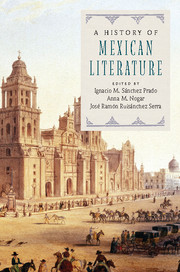Book contents
- Frontmatter
- Contents
- List of contributors
- Introduction
- PART I COLONIAL LITERATURE
- PART II THE NINETEENTH CENTURY
- PART III TWENTIETH AND TWENTY-FIRST CENTURIES
- PART IV MEXICAN LITERATURE BEYOND BOUNDARIES
- 25 The Literatures of Greater Mexico
- 26 Indigenous Literatures of México
- 27 Writing Cinema: The Communicating Vessels of Literature and Film
- 28 Popular Narratives: Telenovelas, Corridos, Historietas, and Other Literary Pursuits
- Index
- References
28 - Popular Narratives: Telenovelas, Corridos, Historietas, and Other Literary Pursuits
from PART IV - MEXICAN LITERATURE BEYOND BOUNDARIES
Published online by Cambridge University Press: 05 July 2016
- Frontmatter
- Contents
- List of contributors
- Introduction
- PART I COLONIAL LITERATURE
- PART II THE NINETEENTH CENTURY
- PART III TWENTIETH AND TWENTY-FIRST CENTURIES
- PART IV MEXICAN LITERATURE BEYOND BOUNDARIES
- 25 The Literatures of Greater Mexico
- 26 Indigenous Literatures of México
- 27 Writing Cinema: The Communicating Vessels of Literature and Film
- 28 Popular Narratives: Telenovelas, Corridos, Historietas, and Other Literary Pursuits
- Index
- References
Summary
Literature and Popular Culture
On the surface, popular culture – associated with the historically illiterate masses – would seem to be utterly disconnected from the elite culture that traditionally has produced and consumed literature. Yet popular culture is not so easily pinned down, referring sometimes to “an authentic rural culture under threat from industrialization and the modern culture industry” and at other moments to what would seem to be its opposite, that is, the mass culture fomented by that modern culture industry. In still other contexts, popular culture may be understand in a more positive forward-looking way as “an emancipatory and utopian charge, whereby the practices of oppressed classes contain within them resources for imagining an alternative future [Marxist-inspired] society” (Rowe and Schelling, 1991: 2). The popular might refer in different contexts to the grassroots core traditions of national culture, to the broadest (and least locally oriented) shared cultural experiences disseminated through the globalized mass media or to organic essences in whose pureness lies the key to resisting colonial and imperial impositions.
Literature, a notion imported to the Americas from Europe through colonial channels, opposes itself to popular culture. It is often imagined as distinctively not authentic, traditional, or rural, but rather unapologetically artificial, urban, elitist, avant-gardist, and modern. In Latin America, in particular, literary culture tends to be associated with urban-centered national networks of biopower, which have been studied under the rubric of “the lettered city” (Rama, 1984). Literature's purity, then, lies not in its genuineness, but rather in its artifice, the cultured creativity and individuality of the intellectual elite in the face of a cultural mainstream geared toward the undiscerning tastes of the masses. In Mexico, however, this abyss between the literary and the popular seems not to be without significant bridges, many of which date back to the foundational era of national culture.
Literature's Popular Origins
For many literary historians, José Joaquín Fernández de Lizardi's El Periquillo Sarniento marks the birth of the quintessential form of modern literary expression, the novel, in Mexico. Such a distinction bestowed upon the rather messy work of a mere journalist would undoubtedly have been met with disapproval by Lizardi's more lettered contemporaries, especially given this prolific writer's insistence on incorporating vernacular language and vulgar contexts.
- Type
- Chapter
- Information
- A History of Mexican Literature , pp. 426 - 440Publisher: Cambridge University PressPrint publication year: 2016



